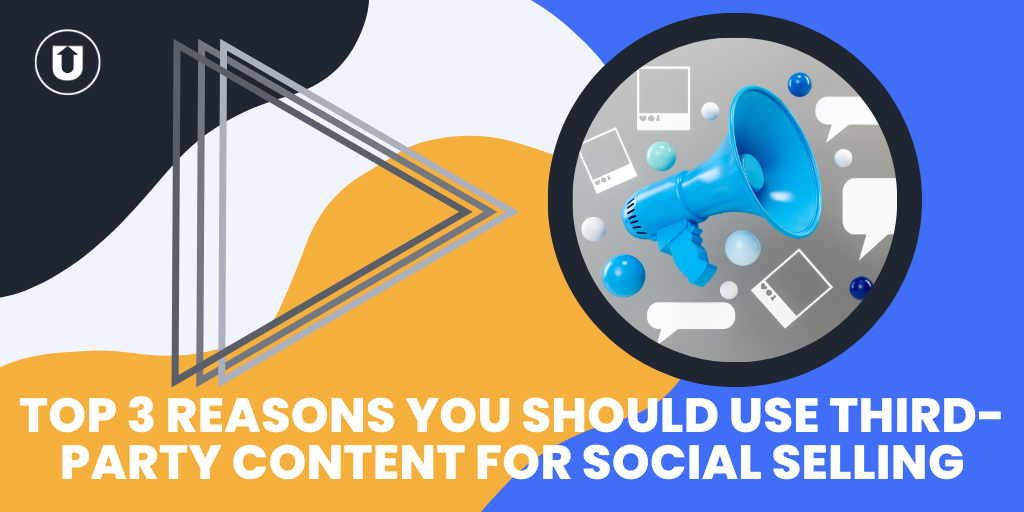The 6 Biggest Mistakes Social Sellers Make

Whether you like it or not, people spend most of their time online in some capacity now, and sales professionals have had to shift their strategies to hang out with their prospects where they are spending most of their time - online.
That’s essentially what social selling is - using the same sales techniques people have used in the past but adapting them to online spaces like social media.
Sales reps using social media as part of their sales techniques outsell 78% of their peers.
But it’s not a foolproof strategy -- it’s just that, a strategy. It requires skill, thought, and intention.
Hiding behind our laptops and phones makes us susceptible to blunders we won’t always make in person, and they have just as lasting of an impact as some of the biggest sales mistakes.
Here at UpContent, we help hundreds of sales reps across various industries, like financial services, insurance, real estate, and more, find the best curated content for their social selling and employee advocacy efforts.
We’ve seen a number of strategies that are effective but also some pretty big mistakes that can derail their social selling efforts.
We created this guide on the six biggest mistakes we often see social sellers make and how you can fix or avoid them.
Mistake #1: Overemphasis on Selling, Underemphasis on Engagement
Have you ever seen someone posting on LinkedIn all the time, sharing great content, but EVERY SINGLE POST ends with a call to action to Book a Demo”, “Fill Out A Form,” or “Do something to get in my sales funnel!”
It’s annoying, isn’t it?
Social platforms are communities built on interaction, not just billboards for advertisement.
When sellers prioritize their sales pitch over the value of the content, they risk becoming white noise in the crowded social space instead of the thought leaders they are striving to be.
Practically speaking, the only segment of your audience that has the potential to engage in a promotional post is the one representing individuals who are ready to buy (traditionally the smallest segment).
This imbalance can turn potential connections cold, as modern consumers expect to receive value before they're willing to give something away.
Nobody wants to give you their email address or phone number just to be put in some sort of sales funnel without getting something they want in return.
And you should be giving value way more than asking for something in return. Otherwise, people will feel drained by you and your content.
Solution: Engagement First, Sales Second
To combat this, social sellers must embrace a paradigm shift: engage first, sell second. Make “giving” your default move.
Engagement is the currency of social media, and your content must be rich in value to earn it.
Begin by sharing content that addresses your audience's pain points, provides solutions, and sparks conversation. This content can come from your company, from the publications you read, or from a reflection on personal experiences.
This doesn’t always have to be content directly related to your solution, but indirect content can be just as if not more effective in stirring up conversation.
Engage with your followers by asking questions, seeking their opinions, and participating in discussions. This engagement builds trust and relationships, which are foundational before any sale can occur.
Before asking for anything from your audience, provide them with actionable value.
This could be in the form of educational content, industry insights, or free tools and resources that address their needs and challenges. By doing so, you’re not just selling a product but providing a solution.
Mistake #2: The Seller Takes Center Stage
If you’re only posting content that talks about you, what you care about, or what you think, you’re gonna hurt your reputation with your audience.
We get it. You’re trying to help people get to know you online - which is harder to do genuinely.
People don’t care about your story unless it will help make their story better.
Think about some of your favorite LinkedIn creators - how often do they post about themselves?
We all avoid that one guy at the dinner party who only talks about himself, so don’t be that guy. Be genuinely interested in your audience. Curiosity is the #1 trait of an effective seller, and it is no different online.
Solution: The Audience as the Protagonist
To avoid this, shift your narrative to cast your audience as the protagonist in the content you’re sharing.
You should serve as a guide, not the hero of the story.
How you speak of others, share success stories, and what you say about third-party content will reflect who you are as a person and social seller; let your audience read between the lines. It’s more impactful that way.
Mistake #3: Taking Yourself Too Seriously
There’s a difference between being professional and unrealistic.
All too often, we see social sellers trying to be something they really aren’t in person.
Corporate culture has permeated online spaces, creating an inauthentic feel, and if the content you’re sharing feels too polished, branded, or vague, your audience will see right through the facade.
While company channels usually have stricter guidelines on what they can share because of brand guidelines, you have the chance to demonstrate who you are as a human, not just an extension of your company.
Solution: Be Yourself
You are not a company brand channel.
You are you. Let your perspective shine.
We all know this isn’t your day job, so if things look too polished or don’t match up with the “you” we know, your audience will discount it. Let your voice shine through!
Mistake #4: Sacrificing Authenticity for Automation
Automation in social selling can be a double-edged sword.
While it can help manage tasks and maintain consistency, over-reliance on automation can strip away the personal touch that makes social selling so effective.
Customers seek authentic connections, and automated messages can be impersonal and disingenuous.
But this isn’t just including someone’s first name in an email. Personalization is tailoring your message to what you can share that would be interesting to each individual audience member.
Solution: Authentic Interactions
This is where diversifying the type of content you’re sharing can help you.
No, it’s not feasible to personalize every single piece of content to each individual member of your audience, but that doesn’t mean you can’t organize it to be more intentional.
Financial Media Exchange’s CEO Ric McConkey categorizes the content strategy into a three-layer funnel:
- One-to-one communications
- One-to-a-few communications
- One-to-many communications
The first two layers should be personal, intentional, and customized based on who you’re talking to, but the third, one-to-many, can be easily automated (to the point where you add your “hot take”) while still staying on brand and message.
For “one-to-many” communications, the personalization is to your perspective and expertise while considering the larger interests of your audience.
This could look like tailoring your one-on-one emails and outreaches individually with some research, segmenting your one-to-a-few with tailored content to their niche, and automating curated content to the point that it is ready to be shared with you simply adding a bit of perspective prior to posting to your socials for one-to-many conversations.
Mistake #5: Inconsistent Online Presence
An erratic presence on social media can be just as detrimental as no presence at all.
Inconsistency can lead to a decline in audience retention and engagement, causing your brand to lose its hard-earned standing in the social sphere.
Not only will the algorithms not show your random content, but you will also come off as inconsistent and unreliable. Remember how your audience can read between the lines?
Having a random shotgun approach with no strategy or consistency is going to leave you screaming into the void, and it’s lonely out there.
Solution: Consistent and Predictable Engagement
The solution is obvious but not always easy: provide a consistent, predictable pattern of content, engagement, and value.
Consistency helps build a reliable brand presence that audiences can trust and look forward to engaging with.
Using a platform like UpContent can help you automate your communications so you don’t have to constantly find and share curated content, and you can focus on creating and providing value in your individual conversations.
Mistake #6: Disregarding Customer Feedback
Ignoring customer feedback on social platforms is akin to turning a deaf ear to the market's pulse.
Engagement doesn't end at pushing out content; it involves listening and responding to the comments, messages, questions, and discussions it generates.
HubSpot’s VP of Platform Ecosystem, Scott Brinker, says that one of the biggest mistakes he sees happening online is people not responding to what people are saying about their content.
You should react as if you were all sitting around a table discussing the topic, so responding as genuinely as you would in person is key to growing your credibility and presence.
Neglecting this feedback is a missed opportunity for growth and connection.
Solution: Embrace and Act on Feedback
Social sellers should not only listen to customer interactions but actively seek them out and do something with the feedback.
This shows you value your customers' opinions and are committed to continuous improvement.
Engage with comments, conduct polls, and ask for suggestions to demonstrate responsiveness and adaptability.
If your audience is engaging with a certain topic more than others, use that to key in on their problems or concerns.
Everyone wants to be heard, and if you’re the one answering their questions, they’re going to trust you a lot faster than someone who is just sharing content with no response to their comments or questions.
Avoiding These Biggest Social Selling Mistakes
Social selling requires more than just a savvy understanding of social platforms; it demands a deep appreciation of the nuances of human interaction and value exchange.
Remember, the essence of social selling lies in building relationships, not just closing sales. By engaging genuinely, offering value, maintaining consistency, and listening to your audience, you're setting the stage for a thriving digital community around your brand.
Each interaction, each piece of content, and each response to feedback is a step towards establishing trust and credibility — the cornerstones of successful social selling.
UpContent is dedicated to empowering professionals like you with the tools and insights necessary to excel in social selling. Our content curation software is designed to help you find and share high-value third-party content that enhances your credibility and thought leadership.
Ready to elevate your social selling strategy? Watch a demo of UpContent to see if adding or simplifying your curated content discovery process is right for your social selling or employee advocacy efforts.
Or, if you’d like to read how we have helped other social selling programs, check out some of these success stories below!
More Curated Content = More Leads
Top Hospital in Louisiana Sees 80% Adoption Rate In Their Employee Advocacy Program Using UpContent



